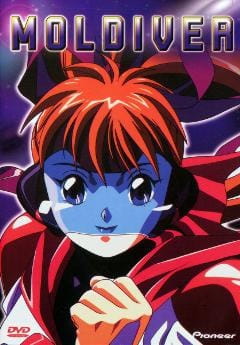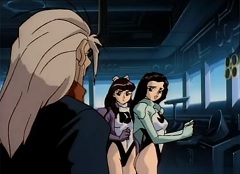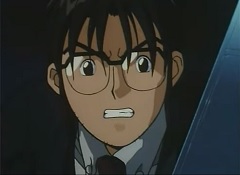
Moldiver
Sometimes there’s an anime that comes along where one wishes they could like it more, but all things considered must concede that it’s okay at best. A good example of this is Moldiver. It looks nice and has quite a few exciting fight scenes, but the story needed a lot of work. Between having annoying characters and much of the humor being Japanese pop culture references from the 80s and 90s that most today won’t pick up on, it’s hard to get drawn into all of the things going on in this six episode OVA.On the surface, there should be quite a bit to like about the show. It is basically a vehicle for parodying Japanese super heroes where a college boy named Hiroshi Ozora develops a fancy gadget that allows whoever possesses it to transform into a super hero with a suit and cape that gives them amazing strength, speed, and they become impervious to harm. He names it the Moldiver and uses it a few times, but what winds up happening is that his little sister Mirai gets a hold of the device and becomes the hero. All of this is while they fight against a mad scientist by the name of Machinegal who collects retro technology with his team of buxom androids. Much of this unfolds as adventure of the week material, while an ongoing subplot develops about a space program to send humanity to a distant galaxy.
For the most part, this is fine. On a very basic level, the story is at least moderately enjoyable. Unfortunately, Mirai is extremely annoying. She’s selfish, short-sighted, and can be quite rash. Perhaps the folks at AIC who worked on this thought it would make her character endearing somehow, but for many it will likely have the exact opposite affect. The situations she gets herself into and how she justifies her actions makes the girl insufferable. Meanwhile, the show requires viewers to be extremely generous in their suspension of disbelief. There are so many logical flaws in the story. For example, Hiroshi uses his computer to develop the Moldiver device, but doesn’t appear to put any sort of password protection on it, resulting in his siblings both getting access to his data. In another episode, crews are salvaging an old battleship (the Yamato), which, by the time of the series, has been underwater for 100 years. Somehow, there isn’t any water inside the ship, and its interior is in perfect condition. These are a couple of the bigger cases, but there are plenty of other instances in the series that will have viewers shouting, “Oh, come on!” Then there is the matter of the show’s humor. Some of it is slapstick and simple to follow, like how there is a male and female form of the Moldiver with Mirai stuck as a male from time to time. However, there are quite a few moments where the show is referencing pop culture happenings that were going on in Japan almost 30 years ago. Most viewers just aren’t going to pick up on this, which will cause the jokes to fall flat on their face.
While the story leaves much to be desired, the art and overall animation is respectable. All of the characters have their own look, while adhering to fairly standard mid-90s character design templates. There is quite a lot of fan service given that the Moldiver transformation sequence requires the user to be naked at the time. Then there are Machinegal’s female androids who are all quite voluptuous while essentially walking around in swimwear with large should pads much of the time. So things like this played heavily into character design. The Moldiver suits are pretty good looking as well. While the male one is a bit on the utilitarian side, the female version has some nice accents that makes it look quite nice. All the while, the show takes place in Tokyo circa 2045 with some interesting futuristic touches being added to the city like a group of massive towers that people live in, connected to one another by a series of gondolas.
Where things get interesting is the action itself. Mirai frequently gets into fights with Dr. Machinegal’s dolls. Either they’ll be in robotic contraptions of some sort blasting lasers at her, or they’ll be in exo suits getting into ridiculously amplified fist fights. Whichever way things go, it’s a guarantee that there will be a lot of collateral damage as huge chunks of Tokyo get damaged in these battles. These fights are a lot of fun as they are very kinetic thanks to how fast Mirai can move around. Between that and watching highways get destroyed, these scenes do a lot to drag the anime into being a somewhat decent show rather than terrible.
Musically, Moldiver has a lot of orchestral themes. They sound alright, but are present more to mock typical Japanese super hero shows, as these pieces add an overly serious tone to the scenes that they appear in. Besides these moments, there is also quite a lot of synthy incidental music that crops up. Most of this is well done, but doesn’t show up enough, so it’s disappointing when these tunes stop.
On the whole, it’s tough to recommend Moldiver. Sure, the action is a good time, but the story, characters (mostly Mirai), and humor are so bad that for most it will leave a bad taste in one's mouth. At most, it might be worth watching for people who want to check out an anime focused on lampooning super heroes, but even then, this is going to be a very tough sell.
- IroIro
January 3, 2020
More Anime from the Early 90s We've Discussed:
- Bounty Dog Review- Gude Crest: The Emblem of Gude Review
- The Weathering Continent Review
Studio: AIC
Released: 1993
Episodes: 6

DVD Cover Art

Mirai fighting a doll

Dr. Machinegal on the pristine bridge of the Yamato

Hiroshi, creator of the Moldiver